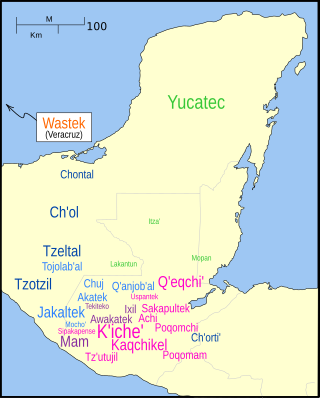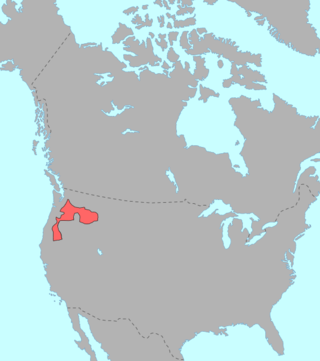In linguistic typology, split ergativity is a feature of certain languages where some constructions use ergative syntax and morphology, but other constructions show another pattern, usually nominative–accusative. The conditions in which ergative constructions are used vary among different languages.

Hurrian is an extinct Hurro-Urartian language spoken by the Hurrians (Khurrites), a people who entered northern Mesopotamia around 2300 BC and had mostly vanished by 1000 BC. Hurrian was the language of the Mitanni kingdom in northern Mesopotamia and was likely spoken at least initially in Hurrian settlements in modern-day Syria.
In linguistic typology, ergative–absolutive alignment is a type of morphosyntactic alignment in which the single argument ("subject") of an intransitive verb behaves like the object of a transitive verb, and differently from the agent ("subject") of a transitive verb. Examples include Basque, Georgian, Mayan, Tibetan, and certain Indo-European languages. It has also been attributed to the Semitic modern Aramaic languages. Ergative languages are classified into two groups: those that are morphologically ergative but syntactically behave as accusative and those that, on top of being ergative morphologically, also show ergativity in syntax. No language has been recorded in which both the morphological and syntactical ergative are present. Languages that belong to the former group are more numerous than those to the latter. Dyirbal is said to be the only representative of syntactic ergativity, yet it displays accusative alignment with certain pronouns.

In linguistic typology, nominative–accusative alignment is a type of morphosyntactic alignment in which subjects of intransitive verbs are treated like subjects of transitive verbs, and are distinguished from objects of transitive verbs in basic clause constructions. Nominative–accusative alignment can be coded by case-marking, verb agreement and/or word order. It has a wide global distribution and is the most common alignment system among the world's languages. Languages with nominative–accusative alignment are commonly called nominative–accusative languages.
In linguistics, a causative is a valency-increasing operation that indicates that a subject either causes someone or something else to do or be something or causes a change in state of a non-volitional event. Normally, it brings in a new argument, A, into a transitive clause, with the original subject S becoming the object O.
In grammar, a reflexive verb is, loosely, a verb whose direct object is the same as its subject, for example, "I wash myself". More generally, a reflexive verb has the same semantic agent and patient. For example, the English verb to perjure is reflexive, since one can only perjure oneself. In a wider sense, the term refers to any verb form whose grammatical object is a reflexive pronoun, regardless of semantics; such verbs are also more broadly referred to as pronominal verbs, especially in the grammar of the Romance languages. Other kinds of pronominal verbs are reciprocal, passive, subjective, and idiomatic. The presence of the reflexive pronoun changes the meaning of a verb, e.g., Spanish abonar'to pay', abonarse'to subscribe'.

Tzeltal or Tseltal is a Mayan language spoken in the Mexican state of Chiapas, mostly in the municipalities of Ocosingo, Altamirano, Huixtán, Tenejapa, Yajalón, Chanal, Sitalá, Amatenango del Valle, Socoltenango, Las Rosas, Chilón, San Juan Cancuc, San Cristóbal de las Casas and Oxchuc. Tzeltal is one of many Mayan languages spoken near this eastern region of Chiapas, including Tzotzil, Chʼol, and Tojolabʼal, among others. There is also a small Tzeltal diaspora in other parts of Mexico and the United States, primarily as a result of unfavorable economic conditions in Chiapas.
Georgian grammar has many distinctive and extremely complex features, such as split ergativity and a polypersonal verb agreement system.
An anticausative verb is an intransitive verb that shows an event affecting its subject, while giving no semantic or syntactic indication of the cause of the event. The single argument of the anticausative verb is a patient, that is, what undergoes an action. One can assume that there is a cause or an agent of causation, but the syntactic structure of the anticausative makes it unnatural or impossible to refer to it directly. Examples of anticausative verbs are break, sink, move, etc.

Nez Perce, also spelled Nez Percé or called nimipuutímt, is a Sahaptian language related to the several dialects of Sahaptin. Nez Perce comes from the French phrase nez percé, "pierced nose"; however, Nez Perce, who call themselves nimíipuu, meaning "the people", did not pierce their noses. This misnomer may have occurred as a result of confusion on the part of the French, as it was surrounding tribes who did so.
Nivaclé is a Matacoan language spoken in Paraguay and in Argentina by the Nivaclé. It is also known as Chulupí and Ashluslay, and in older sources has been called Ashluslé, Suhin, Sujín, Chunupí, Churupí, Choropí, and other variant spellings of these names. Nivaclé speakers are found in the Chaco, in Paraguay in Presidente Hayes Department, and Boquerón Department, and in Argentina in Salta Province.
Transitivity is a linguistics property that relates to whether a verb, participle, or gerund denotes a transitive object. It is closely related to valency, which considers other arguments in addition to transitive objects.
Adang is a Papuan language of the Timor–Alor–Pantar language family spoken on the island of Alor in Indonesia. The language is agglutinative. The Hamap dialect is sometimes treated as a separate language; on the other hand, Kabola, which is sociolinguistically distinct, is sometimes included. Adang, Hamap, and Kabola are considered a dialect chain. Adang is endangered as fewer speakers raise their children in Adang, instead opting for Indonesian.

The Yukulta language, also spelt Yugulda, Yokula, Yukala, Jugula, and Jakula, and also known as Ganggalidda, is a Tangkic language spoken in Queensland and Northern Territory, Australia. It was spoken by the Yukulta people, whose traditional lands lie on the southern coast of the Gulf of Carpentaria.
Yaul, also known as Ulwa, is a severely endangered Keram language of Papua New Guinea. It is spoken fluently by fewer than 700 people and semi-fluently by around 1,250 people in four villages of the Angoram District of the East Sepik Province: Manu, Maruat, Dimiri, and Yaul. Currently, no children are being taught Ulwa, which has led to the rapid decline of intergenerational transmission for this language.
Mekéns (Mekem), or Amniapé, is a nearly extinct Tupian language of the state of Rondônia, in the Amazon region of Brazil.

Avá-Canoeiro, known as Avá or Canoe, is a minor Tupi–Guaraní language of the state of Goiás, in Brazil. It can be further divided into two dialects: Tocantins Avá-Canoeiro and Araguaia Avá-Canoeiro. All speakers of the language are monolingual.
Djaru (Tjaru) is a Pama–Nyungan language spoken in the south-eastern Kimberley region of Western Australia. As with most Pama-Nyungan languages, Djaru includes single, dual and plural pronoun numbers. Djaru also includes sign-language elements in its lexicon. Nouns in Djaru do not include gender classes, and apart from inflections, words are formed through roots, compounding or reduplication. Word order in Djaru is relatively free and has the ability to split up noun phrases. The Djaru language has a relatively small number of verbs, as compared to most languages, and thus utilizes a system of 'preverbs' and complex verbs to compensate. Djaru also has an avoidance language. Avoidance languages, sometimes known as 'mother-in-law languages', are special registers within a language that are spoken between certain family members – such registers are common throughout native Australian languages.

Vamale (Pamale) is a Kanak language of northern New Caledonia. The Hmwaeke dialect, spoken in Tiéta, is fusing with Haveke and nearly extinct. Vamale is nowadays spoken in Tiendanite, We Hava, Téganpaïk and Tiouandé. It was spoken in the Pamale valley and its tributaries Vawe and Usa until the colonial war of 1917, when its speakers were displaced.
Bilingara, also known as the Bilinarra, is an Australian Aboriginal language spoken by the Bilinarra people of the Northern Territory.






